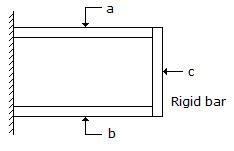Civil Engineering - Strength of Materials - Discussion
Discussion Forum : Strength of Materials - Section 3 (Q.No. 17)
17.
A composite member shown in below figure was formed at 25°C and was made of two materials a and b. If the coefficient of thermal expansion of a is more than that of b and the composite member is heated upto 45°C, then


Discussion:
13 comments Page 1 of 2.
Shailendra kumar said:
9 years ago
If you add a line to maintain the equilibrium than option D is correct.
Ranjit ray said:
9 years ago
Tension in 'b' is due to quick elongation of 'a' because of high coeff. of thermal expansion.
Leo said:
8 years ago
Which material start deforming first? Which has a large coefficient of expansion or low coefficient of expansion? Please describe.
Kallan said:
8 years ago
The load is compressive. So the answer is correct.
Azzu said:
8 years ago
In composite members let A and B.
If the coefficient of thermal expansion of A is more than B.
Then, if temp rise occurs A subjected to compression and B will be subjected to tension.
If the coefficient of thermal expansion of A is more than B.
Then, if temp rise occurs A subjected to compression and B will be subjected to tension.
Jishan said:
8 years ago
Both bars try to elongate (b elongate less than that of a) but due to the rigid bar, their elongations are restricted thus a compression stress develop in both bar.
Shivam kamboj said:
7 years ago
I agree with @Jishan.
Option B is the right answer because it's a rigid bar.
Option B is the right answer because it's a rigid bar.
Aditya said:
7 years ago
Both A and B bars are fixed to the rigid bar C and due to the high temperature, they both try to elongate but due to the rigid bar they can't, so both the bars are under compression but bar A is under more compression because of its higher thermal coefficient.
Prachi said:
6 years ago
I also agree @Jishan.
Both will try to expand because the rate of expansion of bar A will be more as compared to bar B so both will experience compressive force.
Both will try to expand because the rate of expansion of bar A will be more as compared to bar B so both will experience compressive force.
Silence said:
6 years ago
Since the movement is restricted by the rigid support at C so both should be in compression.
(2)
Post your comments here:
Quick links
Quantitative Aptitude
Verbal (English)
Reasoning
Programming
Interview
Placement Papers